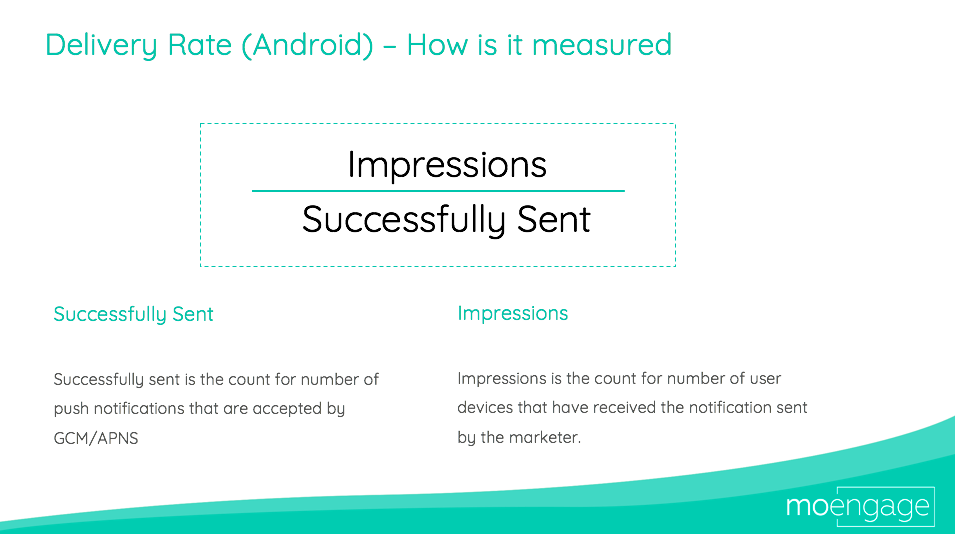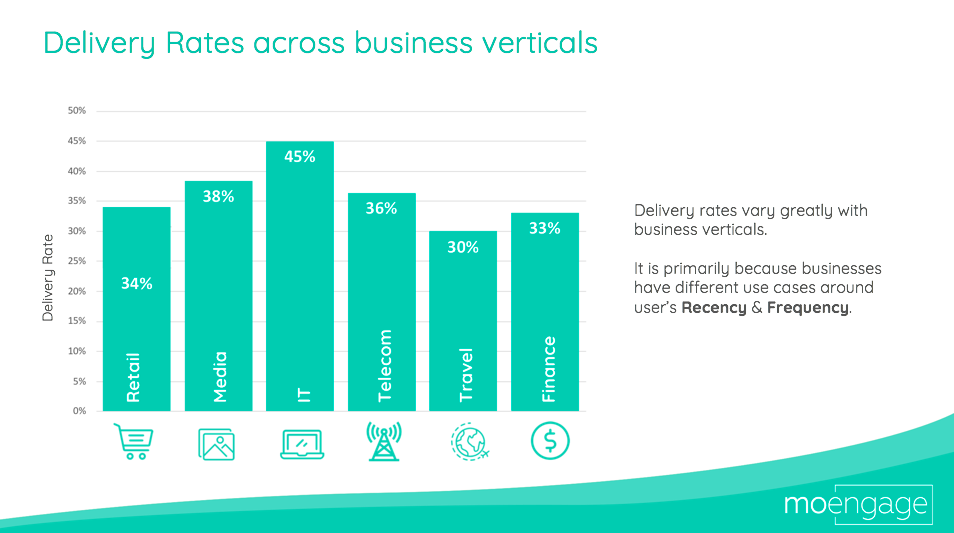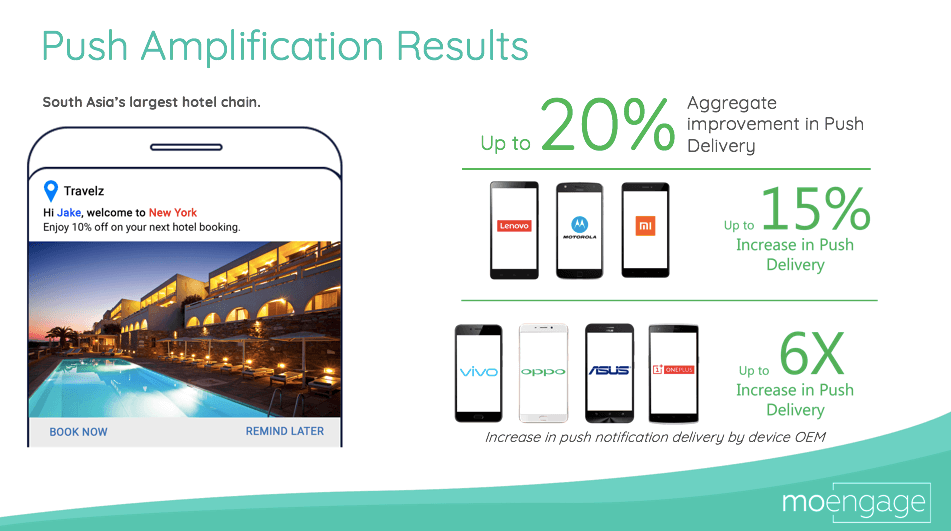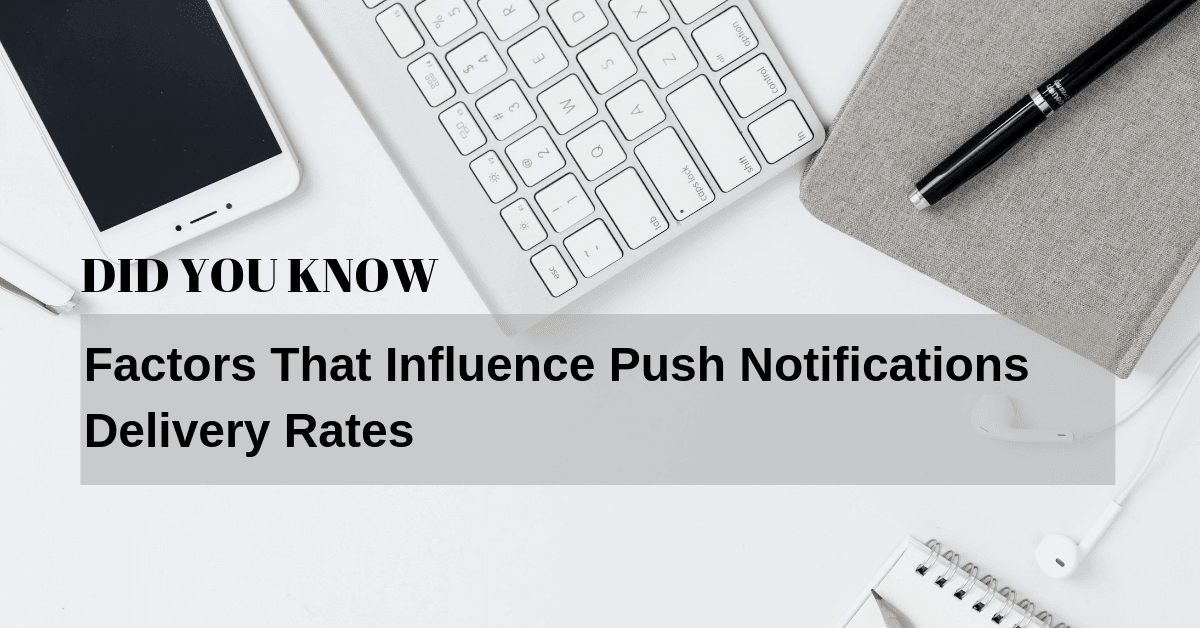Before you read on, you might find our recent whitepaper useful. In this whitepaper, we explain how we used machine learning to build a framework for mobile marketers. This framework predicts push notification delivery rates with 80% accuracy—higher than any other model available right now!
👉 Get the Push Notification Delivery Framework here.
| Bonus Content
👉 Push Notification Benchmarks for Media & Entertainment Mobile Apps, 2021 [Download Report] 👉 Mamikos witnesses 31% Higher CTR with Mobile Push Notification Templates [Download Case Study] |
How is Push Notifications Delivery Rate Measured?
MoEngage measures the delivery rate as the ratio of impressions to the number of messages successfully sent. Most marketers assume the successful delivery of a message to be an indication of delivery success. However, the glitch is that the cloud messaging platform accepts the notifications but fails to send them to devices that are inactive, not connected to the internet, or in an idle mode.

That’s why MoEngage considers Impression as the real measure of delivery success. While this may mathematically result in low delivery rate as compared to other platforms, the CTR will be comparatively higher.
9 Factors that Impact the Delivery Rates in Android Phones

- User Behaviour: MoEngage sends an average of 15 billion messages for all its clients in a month. We have used broad-based campaigns of all the clients to analyze the delivery rates. The results showed that while the delivery rate was around 33% for a broad-based campaign, the delivery rate went up to 48% for a segmented campaign.
- Recency: Our analysis showed a direct correlation between the activity of the user and the delivery rate. For example, the delivery rate was 80% for users who were active in the last 24 hours and 65% for those active in the last seven days. We have introduced real-time triggers that send push notifications to users who intend to exit the app and found the delivery rate to be over 98%.
- Device Manufacturer: With Oppo and Vivo building custom OS on top of the Android that restricts the background network access of the app, marketers find it challenging to deliver notifications to their device users despite their fast growth in the mobile market. However, other devices such as Samsung, Xiaomi, and Motorola have a good delivery rate of 51% to 55%.
- Device Activity: Our analysis shows a sustained delivery within 2-3 weeks of user activity in the case of Motorola, Samsung, and Xiaomi. While Oppo and Vivo show a fast deterioration within the first to the second week, which reinforces our observation that the devices do not receive the notification due to custom OS features.
- Android OS Versions: While the older OS versions such as Lolipop, Kitkat and Jellybean show a decrease in delivery rate, Android N has the highest delivery rate. Oreo, on the other hand, shows a low delivery rate due to Google’s new OS updates such as high battery optimization.
- Device Network: Our analysis found a clear correlation between network latency and delivery rates. We found that WiFi and 4G has a lesser network latency and a higher delivery rate as compared to 2G and 3G that have a higher latency.
- Message Time To Live (TTL): MoEngage users have access to a field called Campaign Time To Live (TTL) that allows them to set a time frame to deliver a campaign. So, if the TTL time frame is high, the GCM or FCM can attempt to deliver the notifications again to users whose device could have been in a switched-off mode or out of connection in the earlier attempt. However, the TTL might not be ideal for time-sensitive campaigns such as flash sales.
- Campaign Send Time: Campaign send-time differs according to the app’s genre and use case. For example, a music app will be most active in the evening when the user is returning from work. So, the notifications sent in the evening will have a high delivery rate. Similarly, 10-11 PM can be the right time for retailers to send push notifications. Deciding a time according to the genre of the app helps in maximizing the delivery rate.
- Business Verticals: Business verticals also has a significant impact on the push notifications delivery rate. For example, a media app will have a better delivery rate due to frequent usage as compared to a retail app used during an offer or sale. Our analysis shows that the recency and frequency of an app can have a direct impact on the delivery rate.

How Can Marketers Improve the Delivery Rate for Push Notifications?
MoEngage’s Push Amplification module improves the push notification delivery rate. The push amplification module is integrated with the SDK to track notifications that are sent to the user and to verify if they have received them. If the notification delivery fails, the Push Amplification module acts as a fallback to GCM and delivers the notification to the device. This solves the problem that marketers face due to custom OS built by device manufacturers such as Oppo, Vivo, and OnePlus.

This has helped marketers improve the push notifications delivery rate by 20% and has already delivered results for South Asia’s leading hotel chain and an over-the-top video service provider by amplifying their push notification delivery by up to 15 times and three times respectively.
If you’d like to learn more about MoEngage and how our intelligent marketing cloud can help you engage, convert and retain your app users, drop us a line at [email protected].
Want to know how brands like Bigbasket, Travelz, and Oyo Rooms use MoEngage Push Amplification to improve their push notification delivery rates? Learn more about push amplification here.








